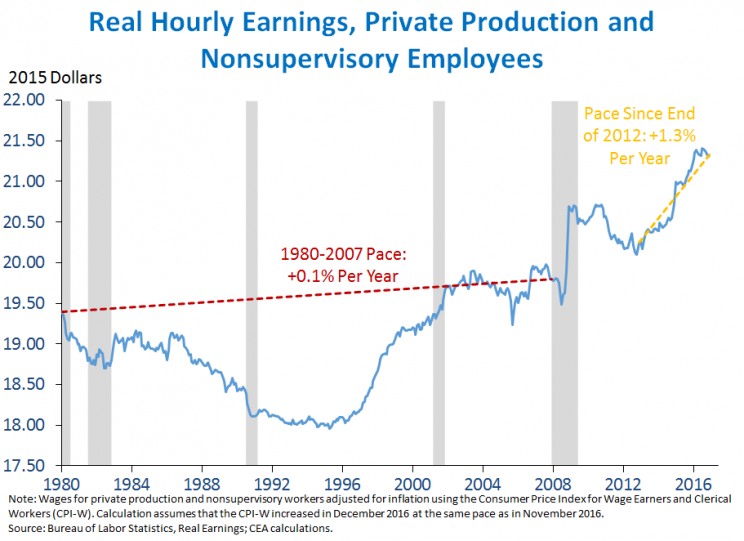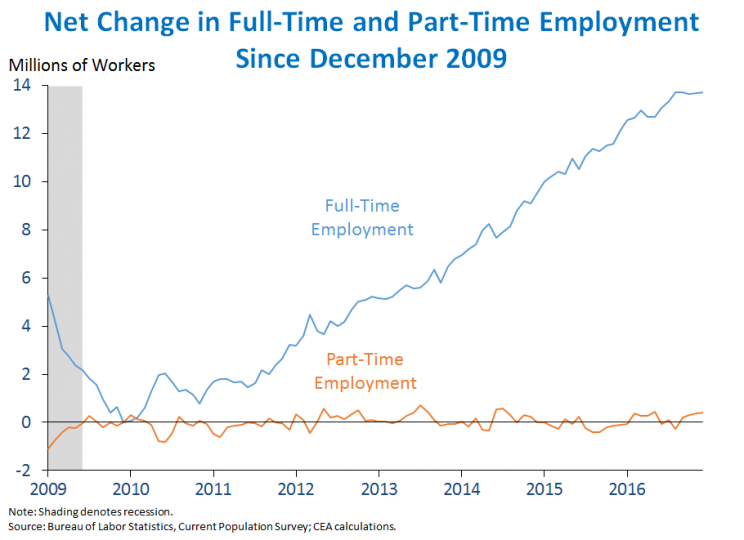President Obama's economic legacy has just been cemented
There is a lot you can say about the economy under President Barack Obama.
But any sober discussion about what was or was not accomplished during the Obama years needs to begin with the labor market. Because if there’s one economic accomplishment you can’t take away from Obama, who took office during the darkest days of the financial crisis, it is that a ton of jobs were added to the US economy during his time in office.
The December 2016 jobs report, covering Obama’s final full month in office, showed that 156,000 jobs were added to the economy. The unemployment rate rose 0.1% to 4.7%, bouncing slightly off November’s post-crisis low of 4.6%. This is down sharply from 10.0%, where the unemployment rate peaked in October 2009.
Perhaps the most important part of this report for financial markets and Fed-watchers was the 0.4% month-on-month improvement in wages, which pushed year-over-year gains up to a new post-crisis high of 2.9%. This was the strongest pace of wage growth since June 2009.

With Friday’s report, 2016 now marks the third-straight year the US economy added more than 2 million jobs. Since the beginning of 2010, 15.8 million private sector jobs have been added to the economy.
In a post published Friday, Jason Furman, Chairman of the Council of Economic Advisers, ran down a number of the labor market related milestones reached during the Obama years.
A few stand out.
75 consecutive months of job gains
December’s report marks the 75th-straight month of nonfarm payroll gains, extending the record streak that now towers over the previous long of 48 months seen during the late-80s.

Furman also noted that this streak comes as the public sector (read: government) has been a net drag on employment growth. “As of December 2016, total nonfarm employment exceeded its pre-recession peak by 6.9 million jobs,” Furman wrote.
“All of the net job creation in the current recovery has been in the private sector, as private-sector payroll employment exceeded its pre-recession peak by 7.0 million jobs as of December.”
Wage growth acceleration
After a long stretch of disappointing data, wages have also started to come around as the labor market has neared (or reached, depending on who you ask) full employment during the later stages of the post-crisis expansion. Full employment is roughly defined by economists as the unemployment rate at which wages begin to accelerate.
Since the end of 2012, nonsupervisory workers have seen wages rise 1.3% per year, lower than total wage gains, but faster than the average seen form 1980-2007.
If you look at the chart below, you’ll see that the last time we really saw nonsupervisory wages accelerating like this was the late-90s, the best economic stretch of the last generation.

Full-time job boom
A common refrain over the last several years has been that the jobs created “don’t count” since it’s just 20-somethings with master’s degrees serving coffee part-time. But this just isn’t so: full-time job creation has far outpaced part-time job creation during the expansion.
“As measured by the household survey, U.S. employment reached a trough in December 2009,” Furman wrote.
“Since then, full-time employment has increased by 13.7 million. In contrast, part-time employment has increased by just 420,000 over the course of the recovery.”

Factors like the rise of the gig economy, the loss of prime-age working men from the workforce, and an elevated underemployment rate all serve as credible counters to the idea that all is swell in the labor market.
The election of Donald Trump should serve as a clear message to politicians, pundits, and citizens that tensions which had perhaps been below the surface of the US economy are making themselves felt and seen.
But if you want to deride the jobs report as full of fluff and only consider the creation of full time jobs as “real,” well, then, a lot of real jobs have been created. In fact, almost all.
Outpacing the rest of the developed world
And finally, for all of the frustrations that millions of Americans feel about the economy and the general direction of the country, it’s worth keeping in mind that things could be a lot worse.
Because for our economic peers in the world, things are a lot worse.
From the beginning of 2010 through the third quarter of 2016, the US, on average, accounted for about 42% of the total employment among the G7 (US, Germany, UK, Canada, France, Italy, and Japan). But over that period, the US has accounted for 55% of the job growth among these countries.

Obama is likely to leave the White House as the only president that didn’t oversee a year of 3% GDP growth since Hoover. The labor force participation rate is hovering near 38-year lows.
And though it’s not perfect, on balance, the labor market Donald Trump will inherit from Obama is the strongest we’ve seen in 20 years.
—
Myles Udland is a writer at Yahoo Finance. Follow him on Twitter @MylesUdland
Read more from Myles:


